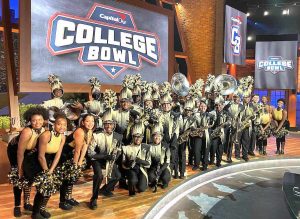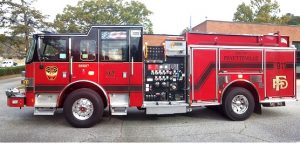Players share memories during documentary filming at local Hit-N-Run batting cages
Nobody was taking any swings on a June afternoon at the Hit-N-Run batting cages in Fayetteville and the sounds of the pitching machines had been silenced.
The place was packed with people of all ages, though, and baseball was on everyone’s mind. The facility, owned by Tim Goodrum, was the setting for an interview of four Negro League baseball players, who spoke for well over an hour about their careers and experiences in a baseball league that rarely gets its due recognition.
Mike “Stinger” Glenn, color commentator for the Atlanta Hawks, and Derrick Dalton led the interview, which also included questions from the audience.
The players who were interviewed were Lawrence “Pop” Williams, who played for the Kansas City Monarchs, James “Red” Moore, who played for the Atlanta Black Crackers, Sam Allen, who played for the Kansas City Monarchs, the Raleigh Tigers and Memphis Red Sox, and Ken Free, who played for the Raleigh Tigers.
Moore, a recipient of an honorary Gold Glove, was introduced as someone who hit an inside the park home run at Yankee Stadium and played with Satchel Paige and Josh Gibson, while Allen played with Willie Mays and Paige and Free also played with Paige. Williams played for legendary manager Buck O’Neil.
The Negro National League was created by Rube Foster in 1920 but other leagues preceded it, going as far back as the 1860s. Free stressed the difference between the time he played, post Jackie Robinson and the time that players like Moore played.
“Post Jackie Robinson, the Negro League became an additional minor league, so our experience was often a lot different,” Free said.
Allen discussed what a typical week was like during his playing time.
“We would play one game a day Monday through Thursday, double headers on Friday and Saturday and sometimes two double headers on Sunday,” Allen recalled. “We might sleep in a hotel three nights a week and on the bus four nights. The conditions were not great, but we really played for the love of the game.”
Allen added that the players got $2 a day for meals and players would often eat things like honey and peanut butter or rice and beans, items that could be purchased inexpensively, to save money.
In some ways, the Negro Leagues were ahead of the major leagues. They played under lights five years before the majors and had an East/West All Star Game that preceded the Major League All Star game by 10 years.
O’Neil, who managed Williams and Free at different times, had his name come up several times and the players informed the crowd who he was.
“He was a great hitter,” said Moore.
“He was a charismatic spokesman for the Negro Leagues,” Allen said, adding with a chuckle, “You think I can talk.”
A story was also told about Paige standing on first base while one of the players was up to bat. The batter hit what would have been a run scoring triple but as he rounded second and neared third base, Paige stood on the bag and asked, “Where do you think you’re going?” The runner responded, “Back to second if I can make it.”
Moore related another story about Paige. Gibson told Moore that he did not like folks digging in on him and the next time Moore was at the plate Paige threw at his head before firing three straight pitches to strike him out.
“I didn’t get the bat off my shoulder,” Moore said.
The stories came fast and furious over the course of the interview. Allen told about playing in the outfield with Mays and making an error because his glove was a three fingered one. Mays told him to buy a glove like his and he wouldn’t make the same mistake. The glove cost him nearly all the money he had at that point but it kept him playing.
Another story was told about “Cool Papa” Bell running the bases so fast that he was accused of cutting across the diamond from first to third base.
The stories are a part of baseball history and that is something that Goodrum and the speakers feel is important to be heard and shared.
The question on everyone’s mind was asked toward the end of the interview: How did it feel to be playing in a separate league? Did you feel mad or discriminated against?
“I felt a lot of discrimination,” Free answered. He was playing in the New York Mets farm system and it would have been better for his career if he were playing on the team in Mobile, Ala., but laws at the time wouldn’t allow it.
“The general manager wondered if they could pass me off as Puerto Rican to keep me there. Makes you wonder if Roberto Clemente was really Robert Clements,” Free joked.
“I didn’t feel bad playing in the Negro Leagues,” Allen said. “It was a treat compared to some other leagues. It was good and bad. Some times I would be eating in the kitchen of restaurants but I was also getting three times as much.”
All of the players stated that they had a love of the game of baseball instilled in them from a very young age. Allen lived near a big ball park and went to games several times a week, collecting foul balls and selling them and listening on the radio when he wasn’t at the games. Free threw tennis balls against a wall and practiced fielding starting at the age of 4. Williams and Moore played against some of the older boys in their neighborhoods and just kept playing.
The players also stressed the importance of introducing the game to young people. Free works with the Metropolitan Junior Baseball League (www.mjbl.org) which is designed to provide urban youth the opportunity to travel to other cities, compete in the game of baseball and to be exposed to diverse cultures.
“The game has been the same for over 100 years and you can play it even if you’re only 150 pounds,” Allen said. “You just have to be able to think, make adjustments and play your position. I’m still in good shape because I had the sense to know not to play football,” he added with a chuckle.
It would be easy to look at the Negro Leagues as a dark chapter in our nation’s history, an example of racism and discrimination that kept thousands of talented athletes from recognition, money and more.
The players on Monday’s panel acknowledged some of that unfairness, but the love of the game and the fact that they did get to play and be a part of history takes away some of the sting.
Being able to tell their stories also helps, as does introducing the history of the Negro Leagues to young people who may never even have known about it. Eyes were opened on Monday afternoon and for a number of young athletes in the audience, the history of the game they love became bigger and richer than they could have imagined.










Leave a Comment
You must be logged in to post a comment.